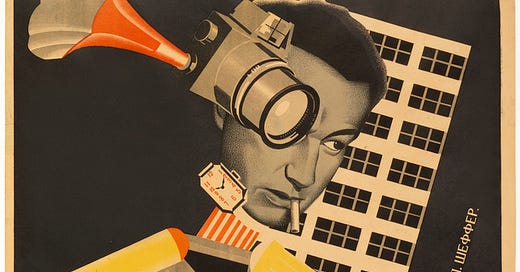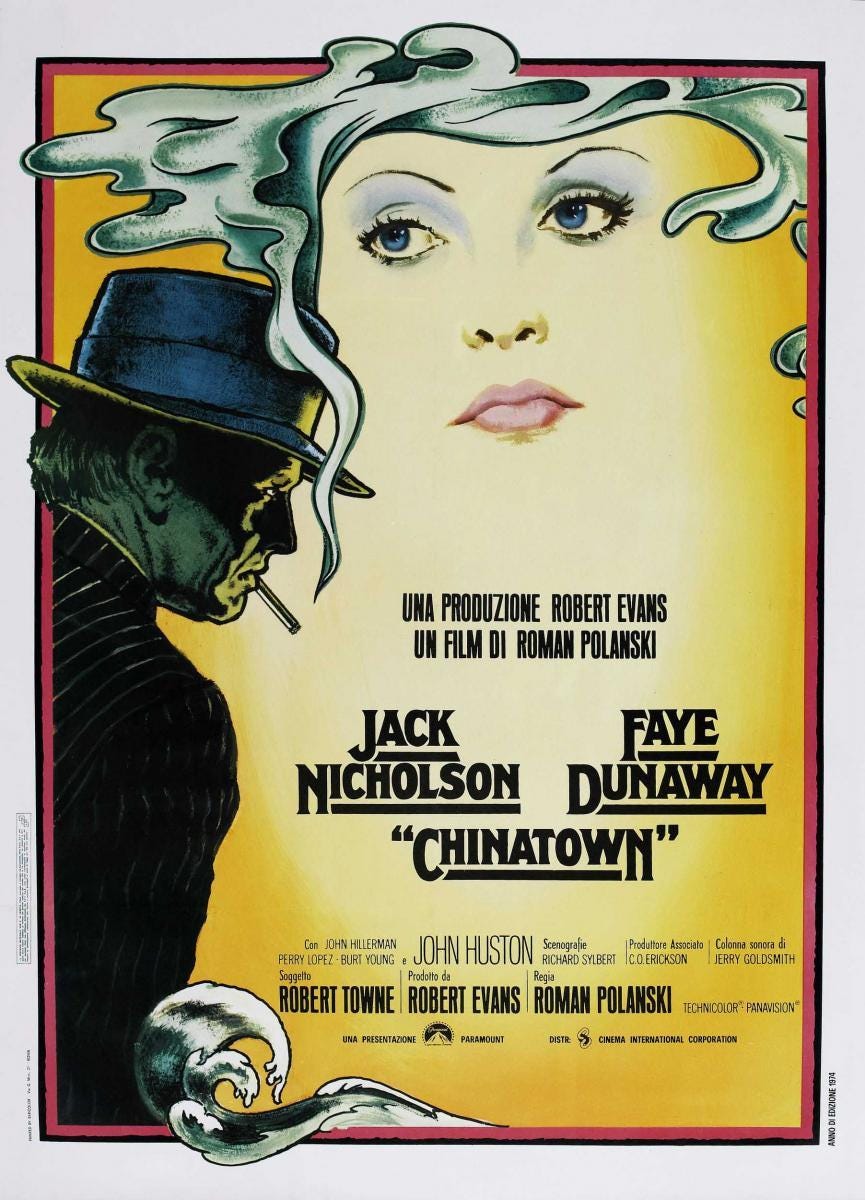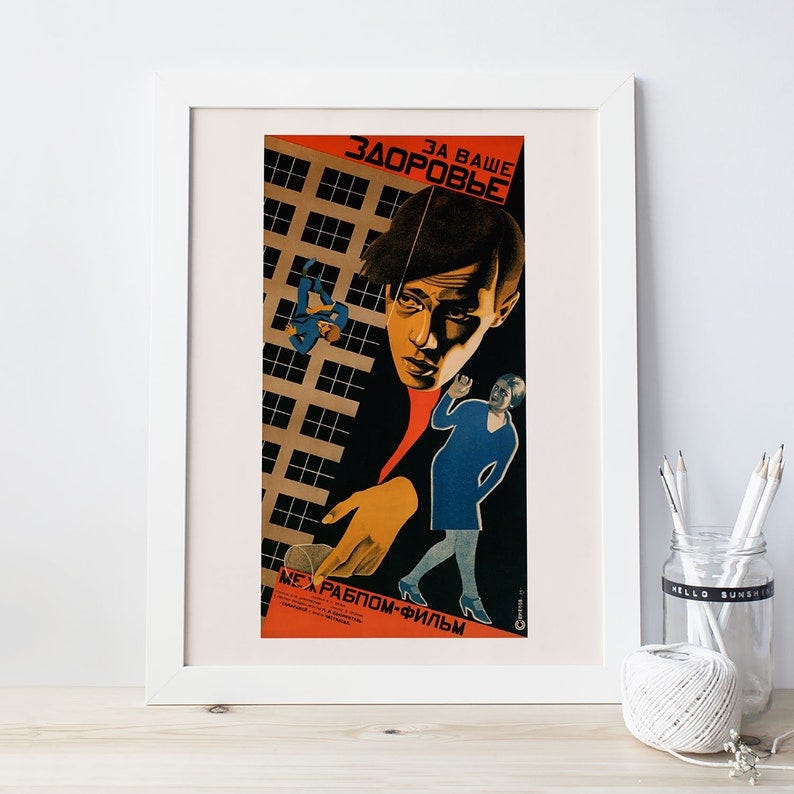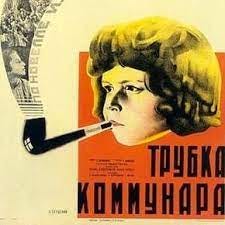Review of "The Utopian Avant-Garde: Soviet Film Posters of the 1920s" Exhibit at Poster House NYC
The Poster House in Manhattan has an exhibit on the film posters of the early Soviet Union, mostly from the 1920s, the years following the Bolshevik Revolution and the Russian Civil War. The posters themselves were experimental works of art every bit as much as the films they were promoting—many of the same innovative techniques used in the films were also used in the posters. The exhibit does a great job of illustrating that. The images themselves are fantastic, colorful, futuristic in the best sense (i.e., not in a reddit Elon Musk sense) and visitors will get a great appreciation for the creativity of the early Soviet Union. However, the overall framing of the exhibit is sinister bourgeois propaganda at its worst (which, since this is an art exhibit in money-makin Manhattan, shouldn’t be too much of a surprise).
The framing of the exhibit is essentially to say, yes, the art itself is beautiful, hopeful, innovative, even revolutionary—but doomed and destroyed by repressive Soviet party rule. This is in keeping with the way that the Soviet Union is always discussed in America—at best, it can be seen as a failed experiment, at worst as rotten from the jump. At no point, however, does the truth of the Soviet Union ever come into play in American consciousness—that Russia overthrew the Tsar, brought millions of illiterate, starving peasants into respectability, defeated Hitler, created amazing art, led the world in science and especially space travel, and on and on. Russiaphobia is nothing new, but it is back in a big way now, as all of the liberal media and political classes posture all day and night about how much they support Ukraine and how evil Putin is. The fact that this exhibit is even up at all is kind of surprising—I guess because it was planned far in advance of the Ukraine war, and they couldn’t cancel it. Even so, despite its celebration of Soviet/Russian art, it is very much framed in an anti-Soviet/anti-Russia way.
The title of the exhibit itself is telling: “The Utopian Avant-Garde.” The utopianism of the art is celebrated by the exhibit, but the Soviet leadership, from Lenin to Stalin, is portrayed as corrupting and destroying this utopianism. The utopianism is also associated with the avant-garde, or cutting-edge elites of Soviet society. This shows a basic lack of dialectics—as if utopian idealism by itself could sustain a society! The dialectical complement of utopian idealism—materialism—isn’t mentioned once anywhere in the numerous essays along the walls accompanying the images in the exhibit. Utopian idealism itself is portrayed as this free-floating wellspring from which the wonderful images came. The framers of the exhibit—bourgeois art world scoundrels to be sure!—seem to think that if utopian idealism was left alone, and not grounded in any kind of historical materialism (as the Soviets required), that would have been better. But we have seen where idealistic, utopian, unfettered bourgeois art leads—to the kind of empty, nihilistic, narcissistic non-art of the West, which is totally given over to the profit-motive of capitalism, or the meaningless self-expression of the individual artist’s ego.
Another theme in the exhibit is how so many of the films that the posters depict were about educating the proletariat masses, and about informing them about the many massive public projects of Stalin’s first Five Year Plan (1928-1932). The exhibit frames this as a bad thing, as if art should have no educational value, but just be art for art’s sake. This, again, is a thoroughly bourgeois, idealist, and utopian view—that art can be this free-floating thing disconnected from the real situation of social, economic, and political life. At best perhaps they would allow that art can comment on social problems, but not instruct or educate the proletariat class about what is going on in the world. Many of the best posters at the exhibit are for films informing the proletariat about major construction projects, like Turksib (1929). This film was a documentary that dramatized the final days of the construction of the Turkestan-Siberian Railroad (abbreviated as Turk-Sib.
In the poster, you can see how the machinery of the railroad construction project is synthesized with the figure of a worker, showing the unity of the material project with the real existence of the proletariat. The message was clear—this massive infrastructure project was made possible by the working-class, for the working-class. But it isn’t a cozy, bourgeois vision of construction, the way we might see in construction propaganda today—if you look at real estate advertisements today, for instance, it depicts bourgeois families enjoying their material comforts in leisure.
This Turksib poster, on the other hand, shows a worker shouting, with his arms up, straining, uncomfortable, creating the material conditions to improve society as a whole. There is nothing comfortable or easy about it. There is a realism to this message that we do not see in art in bourgeois society, because bourgeois society must at every moment. This approach to art is direct, educational, and grounded in material reality—as opposed to bourgeois art, which is supposed to just inspire in a general way. The framers of the exhibit clearly prefer art that inspires, rather than instructs. But art should instruct, if it is communicating something worthwhile, if it has something important to say. Art that just inspires, that leaves interpretation up to the audience entirely, will never have any real impact, and will never communicate anything that will last. Which, of course, is exactly how the bourgeois class wants it—they want art that seems to be very provocative and to shake things up, but which is so unclear, so chaotic, so interpretive, that no good sense is ever made of it, and nobody can really do anything with it.
The films were not just educating the proletariat about the construction projects of the Five Year Plan—many of the films were about important events from Russian history, depicting conflicts between the working class and employer class, or pivotal military conflicts. The House on a Volcano (1929), was about oil workers in pre-Revolutionary Russia who discover that their employer built their houses on top of unstable gas fields. The message is clear—the bourgeois class does not care about its workers. This message was being communicated in these films in the 1920s! Hollywood, to be fair, made some great films about this exact topic, decades later, most notably Chinatown (1974), one of the best movies in Hollywood history—but even that somewhat buries this clear message of bourgeois greed and evil behind a very intricate plot which is all revealed at the end of the film. It’s easy to watch Chinatown and not even fully realize that the message is about the evil of the bourgeois class—the film is, justifiably, more celebrated for its amazing aesthetic value, than for the educational message in it.
There was also a successful Hollywood film on a similar topic called A Civil Action (1998), but that was more of a legal thriller focusing on the personal moral heroism of John Travolta’s lawyer character, than about educating audiences about the evil of the bourgeois class who poisons them to make profits. Indeed, the poster for A Civil Action is just John Travolta wearing a suit and playing with his cufflinks—it’s all about him! And the aesthetics of the poster could not be more drab and less revolutionary. Compare it to the poster for The House on a Volcano, which is so colorful and alive, and communicates the plot of the film much better.
A Civil Action (1998)
The House on a Volcano (1928)
And, again, Chinatown and A Civil Action came out 50 and 70 years after The House on a Volcano, and very tentatively, indirectly communicated the message that the earlier film made clearly and emphatically. Chinatown, to its credit, does have a far more revolutionary aesthetic in its film poster—it almost looks like one of these utopian Soviet film posters! But Chinatown is extremely rare among Hollywood films. It’s almost universally regarded as the supreme aesthetic achievement in Hollywood history, with nothing else really even coming close.
Chinatown (1974)
And even with Chinatown, the end message that audiences take away is one of extreme pessimism and hopelessness—Jake Gittes (Jack Nicholson), the detective investigating the crimes of the bourgeoisie who are poisoning the water supply of Los Angeles, is morally outraged and wants to do something about it—but he is told by his partner, in one of the most famous lines in Hollywood history: “Forget it, Jake, it’s Chinatown.” The message is that you can’t change things in this town, or in any town in capitalist America, because the bourgeoisie control everything. People’s water will keep being poisoned, and there’s simply nothing that can be done about it. Compare this message with the message of the Soviet films, which were about the very real triumph of the proletariat over the bourgeois class that poisoned them for profits.
Some of the Soviet films were also about personal instruction, such as To Your Health (1929), a film warning about the dangers of alcoholism—a very serious issue in Russia! Cement (1928) was a film of social realism depicting the struggle of daily life for workers in a cement factory after the 1917 Bolshevik Revolution. Rather than being pure idealism, this film communicates the hardship of life for workers, even after the bourgeois class was overthrown. The Communard’s Pipe (1929) was a historical film set in 1871, after the end of the Franco-Prussian War, and the beginning of the Paris Commune. Rarely were there films about individual great people who changed the course of history by themselves—which are usually the kinds of films we get from Hollywood (that is, when Hollywood bothers to make historical films at all!).
To Your Health (1929)
Cement (1928)
The Communard’s Pipe (1929)
This quotation from the Russian historian Peter Kenez is printed on the wall of the exhibition: “The demand for films was extraordinary.” The proletariat of Russia after the Revolution wanted knowledge, they wanted education, and film was the best way to achieve that. The films were not didactic, they were not talking down to the audience or forcing them to have a specific view of the world—they were responding to the need of this newly liberated class to make sense of their rapidly changing world. The extremely talented artists who made the films and posters were playing a vital social and even political role. The exhibit frames all of this as the avant-garde artist being controlled by the Soviet regime in a negative way—that their pure artistic impulses were destroyed by Stalin’s brutality. But really it was the perfect synthesis, using advanced artistic creativity in service of proletarian, revolutionary educational ends.
The way that the exhibit would have it would be for the pure creativity of the avant-garde to just have its unlimited fetishistic expression, and not be tied to any real conditions of society. They think it’s a tragedy that the art was used for instructional interpretations of proletarian life. They act like after the Revolution the proletariat was instantly free and self-sufficient and didn’t need any further context or instruction—but in reality, proletariat consciousness must be developed, advanced, and protected against bourgeois consciousness at every point. Art should be used as a tool in this ongoing project, to create something that the world had never seen, but that it desperately needed then (and still needs today!)—freedom for the working class. Revolution is a constant struggle—1917 was just the beginning, and art was the best way to ensure that the victory of 1917 was built upon.
The exhibit also doesn’t have any informational literature about the exhibition that you can take with you, to remember and process all the different historical material you just encountered. They have a little pamphlet about membership, and then they have this interactive pamphlet for kids to use their imagination to create posters, but nothing for an adult to bring home with them for free to help them retain the information that was just presented to them. The exhibit itself, like the view of art they endorse, doesn’t seem to believe that material should be absorbed, remembered, and used; their outlook is bourgeois to the core—just look at the pretty pictures and go home.
Having said all that, it is still worth visiting, to get a sense of the aesthetic power and imagination of early Soviet art—but just be aware of the bourgeois propaganda that informs the framing of it (and go on a Friday when admission is free!).












It took me a while to get to this article, but I'm thankful I saved it in my e-mails.
Now's a perfect time to get into Soviet films, too, since MosFilm started posting movies for free on youtube, subtitled and in high definition.
https://www.youtube.com/c/Mosfilm_eng/featured
Really interesting piece. I like the reference to Chinatown, that is an poignant observation.